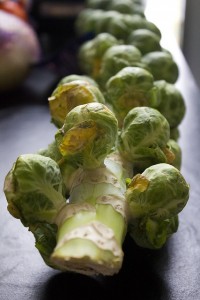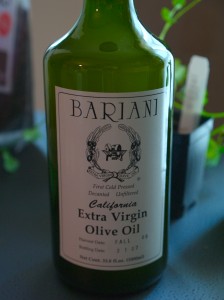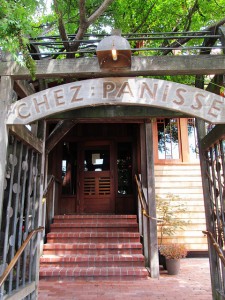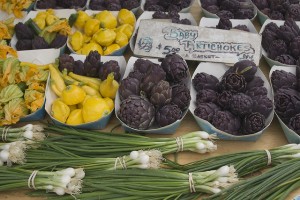
Quinn Dombrowski CC-sa
At the end of one workday not long ago, I brought my children home to feed them. While one set the table and the other practiced piano, I trimmed and halved brussels sprouts. I steamed the sprouts, then tossed them with salt, pepper, and really good olive oil. The children, six and nine years old, happily devoured the sprouts, along with chicken and potatoes left over from an hour’s cooking the day before. For dessert we shared Empire apples: small, dark-skinned, and not too tart. They came from Sebastopol, California, 47 miles north of our home. The vegetable was grown 33 miles south, in Half Moon Bay. The chicken was raised closer, in Sonoma County. The Bariani family grew the olives for my oil in Zamora, California, 93 miles northwest. They bottled it, according to a stamp on the label, exactly 87 days before I drizzled it on the sprouts, from olives harvested, according to a second date stamp, two months before that.
Why does a busy software engineer cook dinner for his children on a weekday instead of purchasing affordable ready-to-eat meals the way most sensible parents do? Why does he serve the children brussels sprouts, the most sulfurous vegetable in the produce section? Why did they enjoy the sprouts anyway? Why the litany of single ingredients — sprouts, chicken, potatoes, apples — and why does he know who produced them? Why are the farms they come from all about the same distance from his home? And for goodness’ sake why does the olive oil have harvesting and bottling dates printed on it? 1I stole this rhetorical-questions-as-introduction gambit from Venkatesh Rao, who graciously let me present an early version of this piece at Refactor Camp.

Elvis Ripley, CC-nc 2.0
The label on the olive oil, with two dates and the name of a family that traces its farming history back to Lombardy, serves as a synecdoche for a food culture endemic to affluent San Franciscans, a culture which ties my strange behavior together and provides the answer to those questions. The culture doesn’t have a single or concise name. “Organic” is too broad. “Slow Food” is better, but distinct. Most accurate are various versions of the adverb-heavy catchphrase “locally and sustainably grown and seasonally consumed.” 2From an interview with Joyce Goldstein, a chronicler and exemplar of Waters’ network: “How do you characterize the style of cooking that developed in California in the 1970s? You can’t sum it up neatly. It encompasses many things, like fresh, seasonal, and local.” That Goldstein is both a slocal food chronicler and a slocal food exemplar is not coincidental. More on this duality later. Let’s call it “slocal food”, the S standing for seasonal, sustainable, Slow, and most of all San Francisco. An awkward term for a slightly awkward ideology.
This culture made itself known to me by yet another name, that of the San Francisco Bay Area restaurant “Chez Panisse”. As a teenager I lived a few miles from it. A pair of affluent, sophisticated neighbors dined there and endeavored to recreate the recipes at home, introducing our family to to the likes of aioli and radicchio. Later Maggie Klein hired me to scoop olives from mouth-watering marinades for the customers of her very similar restaurant. Today as I scan the thirty cookbooks in my kitchen, I see “Chez Panisse” on three of them, all written by its founder, Alice Waters. 3 Chez Panisse Cafe Cookbook, Chez Panisse Fruit, and Chez Panisse Vegetables. I also own Waters’ The Art of Simple Food and her onetime employee Judy Rodgers’ The Zuni Cafe Cookbook.

But I was a latecomer. Slocal food’s origins date to Water’s early adulthood in the late 1960s, when she joined other adventurous Baby Boomers in experiencing Europe on $5 a Day, and in particular European cooking. 4Goldstein: “In those days, you could travel and eat out inexpensively for months and months.” The food of Southern France, Italy, and Spain was a revelation to Waters’ generation of Americans, raised on supermarket fare. She returned inspired. 5Waters is a great self-narrator and a great attractor of writers. Start with the semi-official biography Alice Waters and Chez Panisse, by Thomas McNamee At age 27 she founded Chez Panisse, dedicating it to reproducing what she had experienced in Europe, and specifically to the farm-to-table experiences which were then outmoded even there. 6Waters cites movies of working class life in Provence dating from 1931 as her inspiration. She named Chez Panisse, two successor restaurants, and her only daughter after characters in them. You can see a clip from one in the site’s introduction.
From the beginning, Waters faced a chicken-and-bistro problem. The farms and other suppliers she needed to recreate European country cooking didn’t exist because the market for them didn’t exist. Waters was not a great chef, but she was a remarkable leader, more than equal to the collective action problem she faced. Directing and riding a wave of similarly inspired Boomers, she grew a network of small, high-quality food producers, one mapped today on the restaurant’s web site. 7See also Goldstein, Inside the California Food Revolution:
“[Waters] drove the train of the ingredient revolution. I cannot tell you how many times her name came up while I was interviewing farmers, artisans, and chefs whom she supported and pushed to do more and better.” The site also contains her manifesto:
Alice Waters … is an American pioneer of a culinary philosophy that maintains that cooking should be based on the finest and freshest seasonal ingredients that are produced sustainably and locally. She is a passionate advocate for a food economy that is “good, clean, and fair.” Over the course of nearly forty years, Chez Panisse has helped create a community of scores of local farmers and ranchers [dedicated] to sustainable agriculture.
Consider this statement. First, it sounds like a description of my brussels sprouts and olive oil: local, seasonal, of impeccable quality. Waters created this network of suppliers, and my dinner comes from it both physically and philosophically. Second, it leaves a remarkable amount out. What cuisine does Chez Panisse cook? The site doesn’t say, which is odd because the answer hasn’t changed in forty years: “simple variations on traditional preparations from Provence and nearby regions.” If you were to consider dining at Chez Panisse, wouldn’t you want to know that? Next you might ask by what method the food will be cooked. The answer is often “in our wood oven,” but you will not read that. You might like to know that Chez Panisse has long featured arugula 8Which Waters insists on calling “rocket”, and for the ubiquity of which she is arguably to blame. Perhaps in this case the silence is understandable., or that many days it offers a signature salad of garden lettuces encircling a round of baked goat cheese. All of these matters, which are both diners’ concerns and obvious marketing material, the site’s prose 9The site displays daily menus which show much of this information. My point is that the institution chooses to omit it from its self-description. passes over in silence. Instead, Waters elevates her passion: excellent ingredients harvested recently by a member of her local community in an economy that is “fair” and most of all, sustainable. In Chez Panisse Vegetables, Waters shares this wry summary of her approach to food: “that’s not cooking, that’s shopping.”

Damian Gadal CC 2.0
Chez Panisse Vegetables consists of short chapters on each of a few dozen vegetables, listed alphabetically. From the first three:
- “Amaranth greens wilt quickly, so eat them as soon as possible.”
- “Buy artichokes as fresh as you can, and don’t keep them long before cooking them.”
- “asparagus starts losing its sweetness the moment it’s cut. Therefore, as always, look for the freshest specimens.”
Waters wants you to shop at a farmers’ market several times a week, which means organizing a good portion of your life around slocal food culture. As her editorial voice observes in Chez Panisse Fruit “we disapprove of freezer storage and cooking in large quantities.” 10Chez Panisse Fruit p. 289. I ran across this apt quotation from a recipe for crisp topping as I was finishing this post, because it was time to bake a crisp with two quarts of wild blackberries my children and I had gathered. Nor are such markets available at all times in most places. Eating seasonal fresh ingredients requires a year-round growing season, which is largely limited to temperate and tropical 11 Waters largely ignores the tropics. Chez Panisse uses avocados, which grow locally, and Waters’ “Chez Panisse Fruit” covers the tropical cultivars banana, mango, papaya, and star fruit, but that’s about it. climates with a good mix of precipitation and sunshine. Joyce Goldstein, an early Waters’ employee who went on to write the history Inside the California Food Revolution, makes the obvious point: “In California, we have a big advantage because our seasons are longer, and you can grow just about anything”.
Waters may have acknowledged this crucial limit on her vision’s applicability somewhere, but I haven’t seen it. Certainly she often implies the opposite. Nor is her definition of “local” forgiving. You might think that Mexico would be close enough to qualify, especially given its historical importance to “San Francisco”; you would be largely mistaken. Morocco, 6,000 miles from Chez Panisse, gets perhaps as much exposure on its menu. 12My evidence for this impression is patchy memories, but the recipes in her cookbooks support the point. Chez Panisse also draws little from the Bay Area’s Asian heritage, despite an abundance of local rice, bok choy, etcetera. Waters’ special term “local” has more to do with one’s neighborhood, in the specific sense of a network of people: “The few exceptions to sourcing local products, according to Alice, ‘have to do with friendships–that’s the bottom line for me.’” 13Inside the Californian Food Revolution, Goldstein
“The act of eating is very political,” she said. “You buy from the right people, you support the right network of farmers and suppliers who care about the land and what they put in the food. If we don’t preserve the natural resources, you aren’t going to have a sustainable society. This is not something for Chez Panisse and the elite of San Francisco. It’s for everyone.”
Waters urges “everyone” to have a personal connection to excellent local farmers, a daunting mandate for the world’s more than 7,000,000,000 people. She has been asked how this could possibly work many times. Her answers alternate between the sweeping assurance above and exasperation:
Ms. Waters maintains a stubborn faith that eventually everyone else will do as she does, but she acknowledges that not everyone is there yet. “It’s pretty frustrating when I travel around, but when I see what’s happened in 25 years in this little community, I feel a lot better,” she said. “Every day my job is an excruciating pleasure.”
The assurance and exasperation are the positive and negative forms of a single impulse: emphatic rejection of constraints. In 2011 the New York Times asked Waters what she would order for her last supper. She replied, “I would have a Last Chance peach … in late August or September.” If getting the best meal requires choosing the season of her death, well, so be it.

I don’t recall ever tasting the Last Chance varietal, but every summer I feed my family crates of delicious peaches from Frog Hollow Farms, a slocal provider. My family is Alice Waters’ food: the free-range chicken woven into our muscles, the olive oil woven into our brains. I will always be in Waters’ debt for that. At the same time, slocal food culture, with its sweeping rejection of constraints and, for lack of a better word, reality, has become a part of my mind. About this last development some other parts of my mind have misgivings. Does it really make sense to fill my head with the vital statistics of boutique olive oil? Are there better uses of my time than making stock from free-range chickens? If slocal food’s aggressive pretensions to be for everyone are transparent nonsense, should it really be for me? I have spent decades following a culture whose ideas seem less plausible the more I consider them. How could this not-entirely-benign takeover have happened?
Given that it did happen, what about the other cultures I participate in? Do they hold up any better to inspection? To answer that last question, my next post will consider a culture of the other part of my day, the working hours, and see what it might have to teach us.
References
| 1. | ↑ | I stole this rhetorical-questions-as-introduction gambit from Venkatesh Rao, who graciously let me present an early version of this piece at Refactor Camp. |
| 2. | ↑ | From an interview with Joyce Goldstein, a chronicler and exemplar of Waters’ network: “How do you characterize the style of cooking that developed in California in the 1970s? You can’t sum it up neatly. It encompasses many things, like fresh, seasonal, and local.” That Goldstein is both a slocal food chronicler and a slocal food exemplar is not coincidental. More on this duality later. |
| 3. | ↑ | Chez Panisse Cafe Cookbook, Chez Panisse Fruit, and Chez Panisse Vegetables. I also own Waters’ The Art of Simple Food and her onetime employee Judy Rodgers’ The Zuni Cafe Cookbook. |
| 4. | ↑ | Goldstein: “In those days, you could travel and eat out inexpensively for months and months.” |
| 5. | ↑ | Waters is a great self-narrator and a great attractor of writers. Start with the semi-official biography Alice Waters and Chez Panisse, by Thomas McNamee |
| 6. | ↑ | Waters cites movies of working class life in Provence dating from 1931 as her inspiration. She named Chez Panisse, two successor restaurants, and her only daughter after characters in them. You can see a clip from one in the site’s introduction. |
| 7. | ↑ | See also Goldstein, Inside the California Food Revolution: “[Waters] drove the train of the ingredient revolution. I cannot tell you how many times her name came up while I was interviewing farmers, artisans, and chefs whom she supported and pushed to do more and better.” |
| 8. | ↑ | Which Waters insists on calling “rocket”, and for the ubiquity of which she is arguably to blame. Perhaps in this case the silence is understandable. |
| 9. | ↑ | The site displays daily menus which show much of this information. My point is that the institution chooses to omit it from its self-description. |
| 10. | ↑ | Chez Panisse Fruit p. 289. I ran across this apt quotation from a recipe for crisp topping as I was finishing this post, because it was time to bake a crisp with two quarts of wild blackberries my children and I had gathered. |
| 11. | ↑ | Waters largely ignores the tropics. Chez Panisse uses avocados, which grow locally, and Waters’ “Chez Panisse Fruit” covers the tropical cultivars banana, mango, papaya, and star fruit, but that’s about it. |
| 12. | ↑ | My evidence for this impression is patchy memories, but the recipes in her cookbooks support the point. Chez Panisse also draws little from the Bay Area’s Asian heritage, despite an abundance of local rice, bok choy, etcetera. |
| 13. | ↑ | Inside the Californian Food Revolution, Goldstein |
Interesting article. Our cultural food-consciousness has certainly been raised by Alice Waters’ work. I am prompted to think about the CSA (community-supported agriculture) movement, which is pretty strong over here in the Northeast, as are farmers’ markets during the growing season. I’d be interested to know how developed CSA is in the Bay Area.